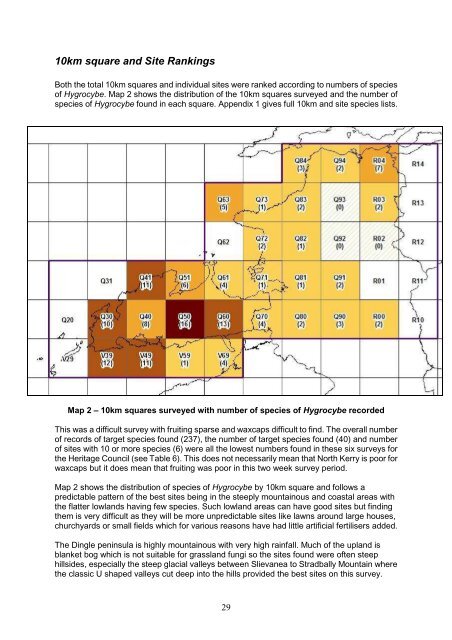North Kerry Waxcap Survey 2012 - the Northern Ireland Fungus Group
North Kerry Waxcap Survey 2012 - the Northern Ireland Fungus Group
North Kerry Waxcap Survey 2012 - the Northern Ireland Fungus Group
You also want an ePaper? Increase the reach of your titles
YUMPU automatically turns print PDFs into web optimized ePapers that Google loves.
10km square and Site Rankings<br />
Both <strong>the</strong> total 10km squares and individual sites were ranked according to numbers of species<br />
of Hygrocybe. Map 2 shows <strong>the</strong> distribution of <strong>the</strong> 10km squares surveyed and <strong>the</strong> number of<br />
species of Hygrocybe found in each square. Appendix 1 gives full 10km and site species lists.<br />
Map 2 – 10km squares surveyed with number of species of Hygrocybe recorded<br />
This was a difficult survey with fruiting sparse and waxcaps difficult to find. The overall number<br />
of records of target species found (237), <strong>the</strong> number of target species found (40) and number<br />
of sites with 10 or more species (6) were all <strong>the</strong> lowest numbers found in <strong>the</strong>se six surveys for<br />
<strong>the</strong> Heritage Council (see Table 6). This does not necessarily mean that <strong>North</strong> <strong>Kerry</strong> is poor for<br />
waxcaps but it does mean that fruiting was poor in this two week survey period.<br />
Map 2 shows <strong>the</strong> distribution of species of Hygrocybe by 10km square and follows a<br />
predictable pattern of <strong>the</strong> best sites being in <strong>the</strong> steeply mountainous and coastal areas with<br />
<strong>the</strong> flatter lowlands having few species. Such lowland areas can have good sites but finding<br />
<strong>the</strong>m is very difficult as <strong>the</strong>y will be more unpredictable sites like lawns around large houses,<br />
churchyards or small fields which for various reasons have had little artificial fertilisers added.<br />
The Dingle peninsula is highly mountainous with very high rainfall. Much of <strong>the</strong> upland is<br />
blanket bog which is not suitable for grassland fungi so <strong>the</strong> sites found were often steep<br />
hillsides, especially <strong>the</strong> steep glacial valleys between Slievanea to Stradbally Mountain where<br />
<strong>the</strong> classic U shaped valleys cut deep into <strong>the</strong> hills provided <strong>the</strong> best sites on this survey.<br />
29


